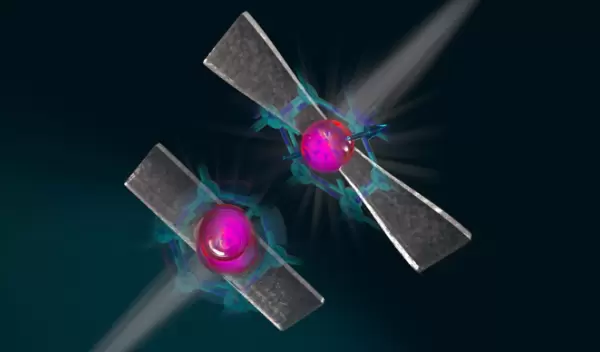
Researchers invent new way to stretch diamond for better quantum bits
A future quantum network may become less of a stretch, thanks to researchers at the University of Chicago, Argonne National Laboratory and Cambridge University.
A U.S. National Science Foundation-supported team has announced a breakthrough in quantum network engineering. By "stretching" thin films of diamond, they created quantum bits that can operate with significantly reduced equipment and expense. The change also makes the bits easier to control.
The researchers hope the findings, published in Physical Review X, can make future quantum networks more feasible.
"This technique lets you dramatically raise the operating temperature of these systems, to the point where it's much less resource-intensive to operate them," said Alex High of UChicago, who led the study.
Quantum bits, or qubits, have unique properties that are of interest to scientists searching for the future of computing networks — for example, they could be made virtually impervious to hacking attempts. But there are significant challenges to work out before it could become a widespread, everyday technology.
One of the chief issues with qubits lies within the "nodes" that would relay information along a quantum network. The qubits that make up these nodes are very sensitive to heat and vibrations, so scientists must cool them down to extremely low temperatures to work.
"Most qubits today require a special fridge the size of a room and a team of highly trained people to run it, so if you're picturing an industrial quantum network where you'd have to build one every 5 or 10 kilometers, now you're talking about quite a bit of infrastructure and labor," said High.
High's lab worked with researchers from Argonne National Laboratory, a U.S. Department of Energy national lab affiliated with UChicago, to experiment with the materials these qubits are made from to see if they could improve the technology.
One of the most promising types of qubits is made from diamonds. Known as Group IV color centers, these qubits are known for their ability to maintain quantum entanglement — connectivity between particles, such as electrons or photons, even when separated — for relatively long periods, but to do so they must be cooled down to just a smidge above absolute zero.
The team wanted to tinker with the structure of the material to see what improvements they could make — a difficult task given how hard diamonds are. But the scientists found that they could "stretch" out the diamond at a molecular level if they laid a thin film of diamond over hot glass. As the glass cools, it shrinks at a slower rate than the diamond, slightly stretching the diamond's atomic structure — like how pavement expands or contracts as the earth cools or warms beneath it.
"The potential for quantum-based information technologies is high," said Tom Kuech, a program director in NSF's Directorate for Engineering. "This project is part of NSF's continuing efforts to provide the underpinning research into the manufacturing science needed to make these approaches a technological reality."
